24 – 26 May 2024, Constanta – Hotel Continental Forum
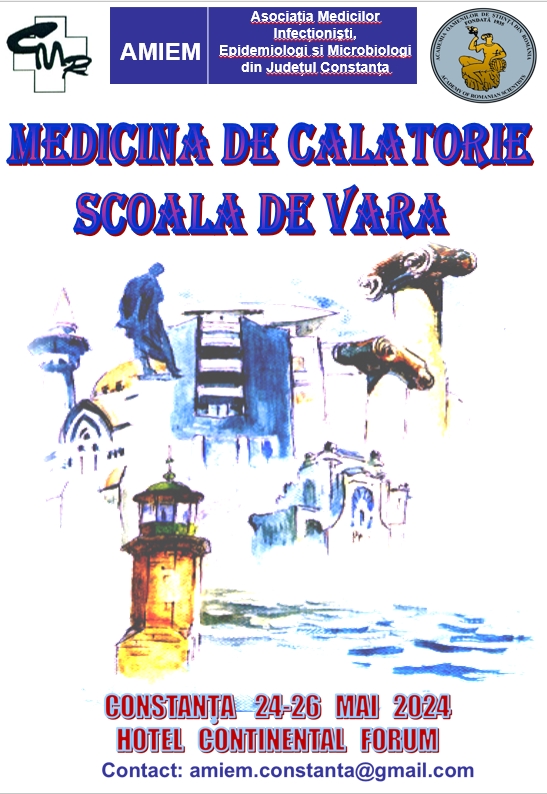
Academics and university professors want to offer the political class, who make the decisions, but also companies in the country a free and impartial expertise on how to solve some of the problems facing Romanian society.
Article by Radiojournal , 14 May 2024
Leading personalities from the country’s academies and universities will provide politicians and decision-makers with a set of conclusions and solutions on how Romania can develop through education, science, research and technology.
The “Romania of Knowledge” project was launched today by the Romanian Academy of Scientists, the National University of Science and Technology Politehnica Bucharest and the University of Medicine and Pharmacy “Carol Davila” Bucharest.
Academics and university professors want to offer the political class, who make the decisions, but also companies in the country a free and impartial expertise on how to solve some of the problems facing Romanian society.
One of the major concerns is the major demographic decline, which is having a strong impact on the economy through a lack of skilled workers.
Moreover, the project “Romania of Knowledge: is structured on areas such as Education, Research and Innovation, Communications, Information Technology and Artificial Intelligence, Efficient and Sustainable Development, but also Reindustrialisation, Efficient and Ecological Agriculture, Culture, Civilisation, Spirituality, Health, Energy and Mineral Resources, Human Resources, Social Policies, Ecology, Environment, Climate Change, Defence, Public Order and National Security. Each project theme will be coordinated by one or two leading personalities in the field.
The working groups are open to specialists from all academies established by law, from prestigious universities, from the Romanian Parliament and other public institutions.
Article published by Agerpres
The project “Romania of Knowledge”, dedicated to the development of the country through education, science, research and technology, vectors of progress and evolution of the economy, society and civilization, was launched on Tuesday by the Romanian Academy of Scientists, the National University of Science and Technology “Politehnica” Bucharest and the University of Medicine and Pharmacy “Carol Davila” Bucharest, in the hall of the Central University Library “Carol I”.
The President of the Romanian Academy of Scientists, Professor Adrian Badea, said that the initiative is addressed to decision-makers from whom he expects feedback.
“We want this national project to be different from other scientific projects, which aim to organise national and international scientific conferences on specific issues. Knowing that in any country in the world, decisions are made not by scientists but by politicians, we thought that this project would address politicians on some of Romania’s current issues, because it is a project for Romania. But we also want the reverse link, that is, when they have problems, decisions to make, they should address this project”, said Badea.
He pointed out that within 10 days of the announcement of the project more than 35 institutions had joined as partners, starting with the Ministries of Education, Research, Innovation and Digitisation.
“We want to offer free, non-partisan expertise to the Government, Parliament, local government, companies and especially SMEs, because none of us has any political bias, we just want to be heard. Of course, we present a point of view. They make the decisions, because that is normal in any country in the world. We hope it will be a successful project,” added the president of the AOSR.
The Rector of the National University of Science and Technology Politehnica Bucharest, Professor Mihnea Costoiu, welcomed the AOSR initiative and pointed out that it aims to alleviate many imbalances faced by Romania.
“Romania is in a major demographic decline, there is also a major economic impact due to the lack of qualified human resources. And we want to draw attention to this in the long term. There is a major impact on state decisions and we want to bring together important actors, the bright minds of society, obviously the Romanian Academy and so on, to create a long-term project. It is a project that will not end today,” said Costoiu.
He added that, as time goes by, the initiators of the project want “to put in front of society more data, collected from open sources, from public data, projects, studies made by different international or national bodies”, with which to base the proposals for solutions they will have in society in the coming period.
Mihnea Costoiu stressed that the “Romania of Knowledge” initiative has no political connotation. “I insist very much, I would not want any political connotation to be given to this event. Under no circumstances,” Costoiu said.
According to rankings covering global knowledge indices such as pre-university education, technological education, higher education, research and development, telecommunications and information technology, economy, Romania “does not rank well enough”, pointed out the rector of the University of Medicine and Pharmacy “Carol Davila” Bucharest, Professor Viorel Jinga.
The State Counsellor in the Prime Minister’s Chancellery Andrei-Ion Ungar sent a message on behalf of Prime Minister Marcel Ciolacu, in which the Prime Minister appreciates that the “Romania of Knowledge” project represents “a benchmark of the future vision of the Romanian academic world”.
“This project is not just an initiative, it is meant to be a vision, a vision for a country where education, research and innovation must be the engine of progress and prosperity, a vision for a society where knowledge must be valued and excellence encouraged in all areas of our lives. The key areas on which this project focuses are the pillars on which a better future for all our citizens can be built. Education, health, technology, the environment, spirituality, culture and more will be the main topics of debate and joint actions of this project. Through the collaboration between the three academic institutions and our common commitment, we are determined to bring positive and sustainable changes in the lives of all Romanians”, said Marcel Ciolacu.
At the event, opened by BCU Director General Mireille Rădoi, other speakers included AOSR Vice-President Doina Banciu, Senate Vice-President Sorin Cîmpeanu, representatives of ministries and universities, and researchers.
According to the initiators, the “Romania of Knowledge” project aims to create a national framework for debate, a think-tank that brings together representative personalities from each field involved, from the country and abroad, scientists, researchers, members of the academic body, experts and specialists, decision-makers and policy-makers.
This forum will address fundamental areas and themes for the process of sustainable development of Romania through knowledge.
The thematic areas and coordinates on which the “Romania of Knowledge” project is structured are: Education; Research, Innovation; Communications, Information Technology and Artificial Intelligence; Efficient and Sustainable Development; Reindustrialization; Efficient and Ecological Agriculture; Health; Culture, Civilization, Spirituality; Energy and Mineral Resources; Human Resources; Social Policies; Ecology, Environment, Climate Change; Defence, Public Order and National Security.
Each area of the project structure will constitute a thematically focused panel and framework, coordinated by one or two leading scientific personalities, emblematic of the respective field. Each panel will also organise “analysis and reflection groups” by sub-domain, which will meet periodically to carry out their work, according to their own agenda, framed within the overall project programme.
The working groups are open to specialists from all academies established by law, from prestigious universities, from the Romanian Parliament and other public institutions.
Debates, scientific meetings, symposia and conferences will take place within each panel and focus group, and the most valuable ideas, conclusions and solutions will be synthesized and disseminated through published materials or in volumes, which will also be distributed to decision-makers in central and local public administration institutions and the Romanian Parliament.
The First Annual International KreativEU Conference, under the theme “Heritage, Science, and Technologies for Sustainable Preservation”, marks a significant milestone in the realm of cultural heritage preservation. Our enthusiasm and commitment to fostering collaborative efforts in this domain are evident in the comprehensive approach we have adopted. We extend a warm invitation to scholars, researchers, practitioners, and emerging academics to join us in this groundbreaking event, where we delve into the complex and evolving interplay between Heritage, Science, and Technologies to ensure the sustainable preservation of our shared cultural legacy.
Our conference embraces a multidisciplinary perspective, acknowledging that the preservation of cultural patrimony cannot be accomplished through isolated efforts. It calls for the convergence of expertise from diverse fields, from archaeology and conservation to law, technology and new technologies, management, marketing, and social sciences. By doing so, we reflect the spirit of our consortium, which is firmly rooted in the belief that innovative and sustainable practices are essential for the effective safeguarding of our rich cultural heritage.
SEE THE AGENDA HERE
First-KreativEU-Conference-ProgrammeBook-of-Abstracts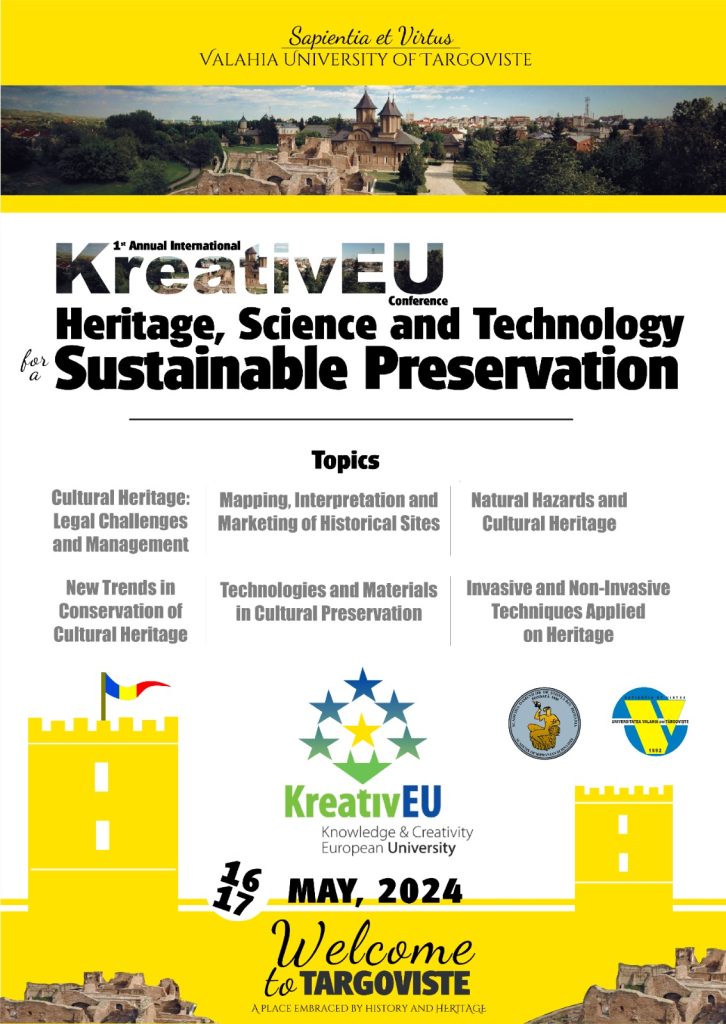
3 (three) special prizes and a Gold Medal with the congratulations of the international jury for the Romanian delegation
At the World Exhibition of Inventions Geneva 2024, held from 16 April 2024 to 21 April 2024 at the PALEXPO International Exhibition Centre, the Romanian delegation participated with a functional prototype for an ergonomic office chair that ensures continuous mobility of the human body skeletal structure during office work. The invention “ANTI-SEDENTARY ERGONOMIC ASSEMBLY FOR THE HOME OFFICE”, was highly appreciated and the International Jury awarded the Siberian inventors a number of 3(three) special prizes and a Gold Medal with the congratulations of the International Jury for which the inventors.
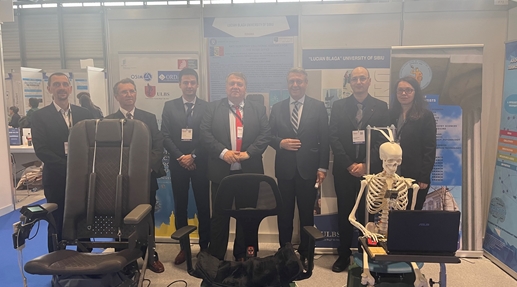
The authors of the invention are: Prof. dr. eng. and dr. ec. Dr. Habil., Dr.h.c. Aurel-Mihail ȚÎȚU, full professor at Lucian Blaga University of Sibiu, Corespondent Member of the Romanian Academy of Scientists, Eng. Mărginean Ion (Sibiu ULBS), Dr. MD. Țîțu Ștefan (Sibiu ULBS and Cluj Napoca IOCN and UMF), MD. Bogorin-Predescu Oana (Sibiu ULBS), Eng. Bogorin-Predescu Adrian (Sibiu ULBS), Eng. Moldovan Alexandru (Sibiu ULBS), Professor Dr. Oprean Constantin (Sibiu ULBS), Honorary Member of the Romanian Academy of Scientists.
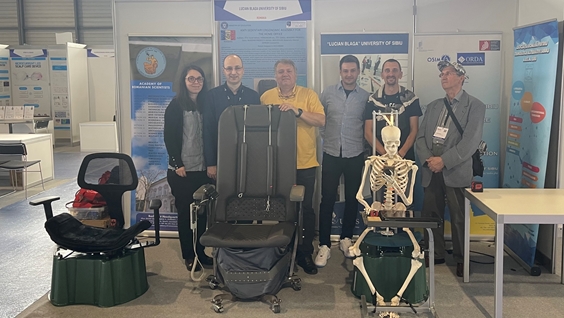
Conf. Dr. biologist Maria S. Celan (1898-1989) is the most important Romanian marine algologist.
She was noticed from her youth by Dr. Grigore Antipa and recommended by Prof. Ioan Borcea for employment at the Marine Biological Station at Agigea, which today bears the name of the Romanian zoologist.
Maria S. Celan continued her training at the Museum of Natural History in Vienna, the National Museum of Natural History in Paris and the Marine Research Stations of Villefranche/Mer, Dinard and Roscoff.
He devoted himself to marine algology with a brilliant doctorate conferred by the famous Parisian Sorbonne University (1940/1941), a thesis that was praised by France’s leading professors in the field.
In her research on morphology, cytology and ecology of green, brown and red benthic macrophytes from the Romanian coast, Maria S. Celan determined 157 species, most of them new to the Black Sea, but she also identified a species new to science, Gelidiella antipaewhich she dedicated to her master, Grigore Antipa.
Through her prodigious professional activity, her upright character and her whole life of sacrifice dedicated to science, Maria S. Celan belongs to the history of Romanian and universal science.
Thus, Maria Celan remains an admirable human role model for current and future generations dedicated to scientific research.
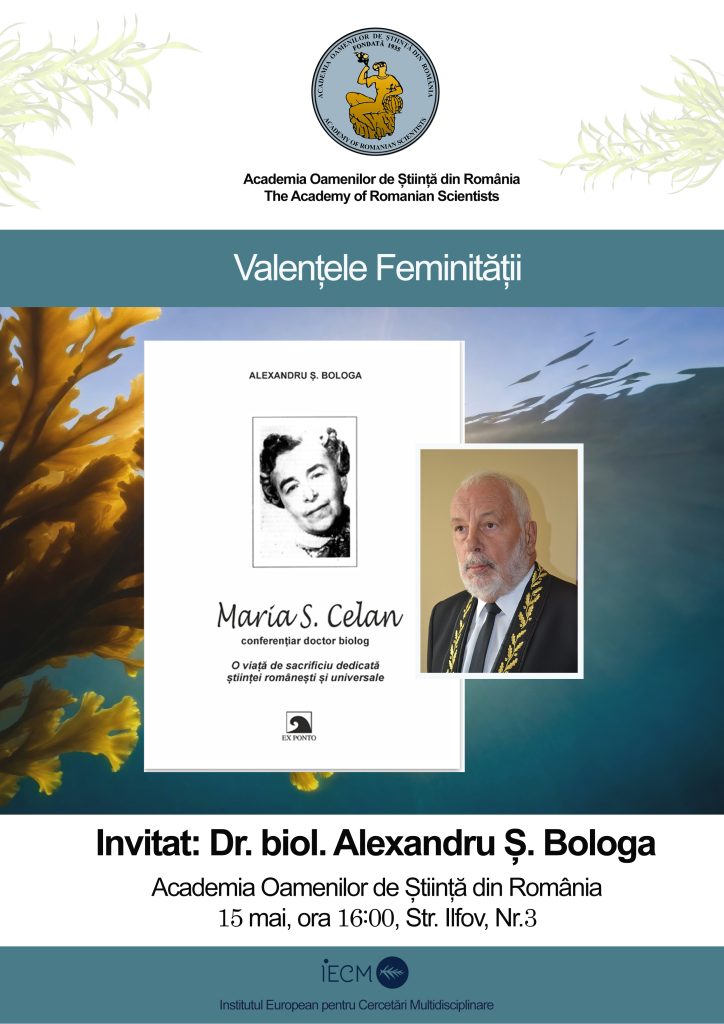
7 March 1928 – 4 May 2024
Honorary Member of the Economic, Legal and Sociological Sciences Section – AOSR
President of the “Henri Coandă” National Foundation for the support of gifted young people, Iulian Crețu is appreciated in economics and industrial aesthetics – design, being a true precursor in these fields. Published works are successfully used in research, promotion and efficiency in all fields, especially in commerce, light industry, education, etc. It is particularly noteworthy the work carried out in the field of scientific research and social and cultural activity for the promotion and recognition of gifted young people within the Henri Coandă National Foundation, being recognized by meritorious results at national and international level in its 25 years of existence.
The General Assembly of the Romanian Academy of Scientists will be held on May 17, at1000 hours, at the Polytechnic University of Science and Technology in Bucharest, Radu Voinea Amphitheatre, with physical attendance.
If the quorum of 2/3 of the voting members is not constituted by this date, the meeting will reconvene on 24 May, at 9:00 a.m., in the Aula of the Central University Library “Carol I”. It will be held with physical attendance, regardless of quorum.
The Spring National Conference of the Romanian Academy of Scientists will take place on 24 and 25 May.
The agenda of the General Assembly is:
1. Presentation and approval of the Report on the scientific activity of the AOSR in 2023 and the Financial Report for 2023
2. Adrian Badea’s speech at the end of two terms as President of the AOSR
3. Election of the Honorary President of the AOȘR
4. Voting of candidates for full, corresponding and honorary membership of the AOSR
5. Election of the new Presidium of the AOSR for the term 2024-2028
6. Miscellaneous
7. AOSR Awards Gala 2022
Please note that members will wear the Academy costume.
The Romanian Academy of Scientists, the National University of Science and Technology POLITEHNICA Bucharest and the University of Medicine and Pharmacy “Carol Davila” Bucharest launch a national project “Romania of Knowledge” on 14 May 2024, 14.00, in the Aula of the Central University Library “Carol I”.
The project “Romania of Knowledge” is dedicated to the development of the country through education, science, research and technology, vectors of progress and evolution of the economy, society and civilization. The project aims to create a national framework for debate, a think-tank that brings together representative personalities in each field involved, from home and abroad, scientists, researchers, academics, experts and specialists, decision-makers and policy-makers, a synergy of creative and innovative minds. In this elite forum of ideas and solutions, subsumed under the objective of sustainable development, fundamental areas and themes for the process of sustainable development of Romania through knowledge will be addressed.
The thematic areas and coordinates on which the “Romania of Knowledge” project is structured are the following:
Each area within the Project structure will constitute a thematically focused panel and framework, coordinated by one or two leading scientific personalities, emblematic of the respective field. Each panel will organise “analysis and reflection groups” by sub-domain, which will meet periodically to carry out their work according to their own agenda, framed within the overall Project Programme. The working groups are open to specialists from all academies established by law, from prestigious universities, from the Romanian Parliament and other public institutions.
Debates, scientific meetings, symposia and conferences will take place within each panel and focus group, and the most valuable ideas, conclusions and solutions will be synthesized and disseminated through published materials or in volumes, which will also be distributed to decision-makers in central and local public administration institutions and the Romanian Parliament.
Prof. Dr. Gheorghe Moroșanu – Department of Mathematics, Babeș-Bolyai University, Cluj-Napoca, full member of AOSR, Mathematical Sciences Section, launched in 2017 the Romanian Itinerant Seminar on Mathematical Analysis and Applications (SIRAMA): http://cs.ubbcluj.ro/rismaa.
Five successful editions have been held so far (Cluj-Napoca, 2018; Constanta, 2019; Alba-Iulia, 2021; Brasov, 2022; Craiova, 2023) and this year the 6th edition will take place, also in Cluj-Napoca (30-31 May 2024).
This itinerant seminar, with two sessions per year, under the coordination of AOSR, will be extended to all areas of mathematics plus applications (instead of “mathematical analysis and applications”) and will be called SEMINAR ITINERANT ROMÂNESC DE MATEMATICĂ ȘI APLICATIONS (SIRMA) (in English, ROMANIAN ITINERANT SEMINAR ON MATHEMATICS AND ITS APPLICATIONS (RISMA).
Participants in SIRMA/RISMA will be members of the Mathematical Sciences Section of AOSR, as well as other researchers interested in mathematics and its applications, Romanian or foreign. The papers resulting from this travelling seminar will be published in Ann. Acad. Rom. Sci., Ser. Math. Appl.